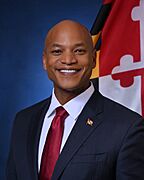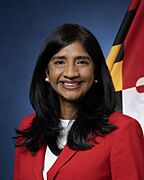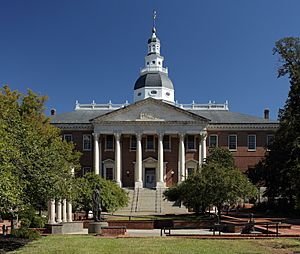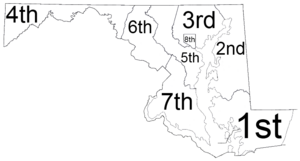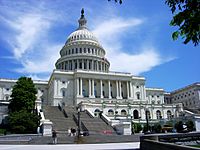Government of Maryland facts for kids
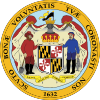
|
|
| Polity type | Sub-national administrative division (federated state) |
|---|---|
| Part of | United States of America |
| Constitution | Constitution of Maryland |
| Legislative branch | |
| Name | General Assembly |
| Type | Bicameral |
| Meeting place | Maryland State House |
| Upper house | |
| Name | Senate |
| Presiding officer | Bill Ferguson, President |
| Lower house | |
| Name | House of Delegates |
| Presiding officer | Adrienne A. Jones, Speaker |
| Executive branch | |
| Head of State and Government | |
| Title | Governor |
| Currently | Wes Moore |
| Appointer | Election |
| Cabinet | |
| Name | Maryland executive council |
| Leader | Governor |
| Deputy leader | Lieutenant Governor |
| Headquarters | State House |
| Judicial branch | |
| Name | Judiciary of Maryland |
| Chief Justice | Mary Ellen Barbera |
| Courts | Courts of Maryland |
| Supreme Court of Maryland | |
| Chief judge | Matthew J. Fader |
| Seat | Annapolis |
The government of Maryland works according to the Maryland Constitution. The United States is a federation, meaning power is shared between the national government and state governments. Because of this, Maryland's government, like those in other states, handles matters that happen only within its borders. However, it must also follow the rules of the Constitution of the United States.
Maryland's government is split into three main parts: the executive, legislative, and judicial. This helps make sure no single part has too much power. Unlike many other states, Maryland also gives a lot of freedom to its counties to manage their own local issues.
Most of the state's government work happens in Annapolis, which is the state capital. However, some state offices are located in Baltimore. Most state and county elections are held in even-numbered years when the President of the United States is not elected. This helps keep state and federal politics separate.
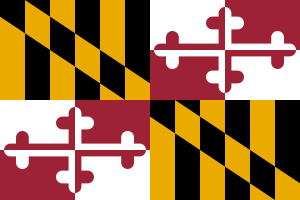
Contents
Executive Branch: Who Leads Maryland?
The Maryland Constitution sets up five main leaders in the executive branch. Four of these leaders are chosen by voters across the state. These are the governor and lieutenant governor (who run together), the attorney general, and the comptroller. The fifth leader, the treasurer, is chosen by both parts of the General Assembly working together.
- Elected Executive Officials in Maryland
-
Anthony G. Brown (D)
Attorney General
Governor: Maryland's Top Leader
The governor is the head of Maryland's executive branch. The governor's team of advisors is called the Executive Council. Like most state governors, Maryland's governor is elected for a four-year term. A governor can serve no more than two terms in a row. The current governor is Wes Moore.
The governor can veto (reject) laws passed by the state legislature. They also have a special "line item veto" power. This lets them reject specific parts of spending bills without rejecting the whole bill. The state legislature can overrule a veto if three-fifths (60%) of the members in each house vote to do so.
The governor has a lot of power to appoint people to important jobs. They choose almost all military and civil officers for the state. These choices must be approved by the Senate. The governor also appoints leaders for major departments, boards, and commissions. They can also fill empty spots for the Attorney General, Comptroller, and in the General Assembly.
The governor is the commander-in-chief of Maryland's military forces. This includes the Maryland National Guard and the Maryland Defense Force. They have special powers during public emergencies.
Lieutenant Governor: The Second in Command
The Maryland Lieutenant Governor is elected with the Governor. They are the second-highest official in the state. The Lieutenant Governor's duties are given to them by the Governor.
Currently, Aruna Miller is Maryland's Lieutenant Governor. This role is not as powerful as in some other states. For example, in Texas, the Lieutenant Governor leads the State's Senate. In California, the Lieutenant Governor takes over all the governor's powers when the governor is out of the state.
In Maryland, the Lieutenant Governor attends meetings and leads special groups. They represent the state at events the Governor cannot attend. They also advise the Governor. If the Governor's office becomes empty, the Lieutenant Governor becomes the new Governor.
Attorney General: Maryland's Chief Lawyer
The Attorney General is the main lawyer for the State of Maryland. This person is elected by the people every four years. There is no limit to how many terms they can serve. The current attorney general is Anthony G. Brown.
The Attorney General is in charge of all the state's legal matters. They give legal advice to the Governor, the General Assembly, and the courts. They also represent the state in court cases, including those in the United States Supreme Court.
Comptroller: Maryland's Money Manager
The Comptroller is Maryland's main financial officer. This person is also elected by the people for a four-year term. There is no limit to how many terms they can serve. The current comptroller is Brooke Lierman.
The Comptroller's job is to oversee the state's money matters. This includes collecting taxes and keeping track of the state's finances. The Comptroller also checks all checks written by the State Treasurer. They make sure state money is handled properly.
The Comptroller's office also checks if taxpayers are following the rules. They collect unpaid taxes and handle laws about unclaimed property. They also pay the state's bills and its employees.
Treasurer: Keeping Maryland's Funds Safe
The Treasurer, currently Dereck E. Davis, is the main person in charge of the state's cash and investments. They manage money from bond sales and other important financial documents. The Treasurer is chosen by a vote of both houses of the General Assembly.
The Treasurer also informs the members of the Legislature about the state's money. They create a yearly report for the Governor, the General Assembly, and the public. This report shares information about the State Treasurer's Office.
Board of Public Works: A Powerful Team
The State Board of Public Works is made up of the Governor (who leads it), the Comptroller, and the Treasurer. This three-person board is very powerful. No other state has a similar group.
The board usually meets twice a month. They review and approve big projects, contracts, and how the state uses its property. This helps make sure important decisions are made carefully and responsibly.
Other Important State Departments
- The Maryland Department of Agriculture (MDA) makes sure food is safe and helps farmers.
- The Maryland State Department of Education (MSDE) oversees public schools.
- The Maryland Department of the Environment (MDE) works to protect our environment.
- The Maryland Department of General Services (DGS) manages state buildings and buys things for the state.
- The Maryland Department of Health handles health-related issues.
- The Maryland Department of Housing and Community Development (DHCD) works on housing policies.
- The Maryland Department of Labor helps with jobs, training, and financial rules.
- The Maryland Department of Natural Resources (DNR) takes care of state parks, forests, and wildlife.
- The Maryland Department of Transportation (MDOT) manages roads, public transit, and airports.
- The Maryland State Archives keeps important government records safe.
Legislative Branch: Making Maryland's Laws
Maryland's law-making branch is called the General Assembly. It has two parts: the Senate with 47 members and the House of Delegates with 141 members. They meet every year for 90 days to work on over 2300 bills, including the state's yearly budget.
Like the governor, members of both houses serve four-year terms. Each house chooses its own leaders and sets its own rules. They can also punish or remove their own members if needed.
The number of seats for each area is updated every ten years after the U.S. Census. There are 47 legislative districts, and each district elects one senator and three delegates. Some larger districts are divided into smaller delegate subdistricts.
The Senate is led by a President, and the House is led by a Speaker. These leaders have a lot of power to guide the law-making process. They appoint members to most committees and choose their leaders. The President and Speaker also lead the daily meetings and make sure rules are followed. When a new law idea is introduced, they send it to a committee for review and public discussion.
Judicial Branch: Maryland's Courts
Maryland's judicial branch is made up of different courts that interpret laws and settle disagreements.
Supreme Court: The Highest Court
The Supreme Court of Maryland is the highest court in the state. It is the final court for most appeals. This court also manages and sets rules for the entire state court system. Before 2022, it was called the Court of Appeals.
The court has seven judges. Each judge comes from one of the state's seven appellate judicial circuits. These circuits are:
- 1st Appellate Judicial Circuit: Caroline, Cecil, Dorchester, Kent, Queen Anne's, Somerset, Talbot, Wicomico & Worcester counties
- 2nd Appellate Judicial Circuit: Baltimore County & Harford County
- 3rd Appellate Judicial Circuit: Allegany, Carroll, Frederick, Garrett, Howard & Washington counties
- 4th Appellate Judicial Circuit: Prince George's County
- 5th Appellate Judicial Circuit: Anne Arundel, Calvert, Charles & St. Mary's counties
- 6th Appellate Judicial Circuit: Baltimore
- 7th Appellate Judicial Circuit: Montgomery County
Appellate Court: Handling Appeals
The Appellate Court is the state's second-highest court. It was created in 1966 to help the Supreme Court with its workload. This court mainly hears cases that are appealed from the circuit courts. Before 2022, it was called the Court of Special Appeals.
Appellate Court judges work in groups of three. Sometimes, all the court's judges will hear a case together. The court has thirteen judges: one from each of the seven judicial appellate circuits and six judges who serve the state at large.
Judges for both the Supreme Court and the Appellate Court are chosen by the Governor. The Senate must agree with the choice, and then the people vote to approve them for a 10-year term.
Circuit Courts: Major Cases and Trials
Circuit Courts are the main trial courts in Maryland. They handle major civil (non-criminal) and criminal cases. They also hear appeals from the District Court and some government agencies. If a case involves more than $15,000, it can be heard by a jury. Juries are only used in Circuit Courts.
The state is divided into eight judicial circuits for these courts:
- 1st Judicial Circuit (7 judges): Dorchester (1 judge), Somerset (1 judge), Wicomico (3 judges) & Worcester (2 judges) counties
- 2nd Judicial Circuit (7 judges): Caroline (1 judge), Cecil (3 judges), Kent (1 judge), Queen Anne's(1 judge) & Talbot (1 judge) counties
- 3rd Judicial Circuit (21 judges): Baltimore County (16 judges) & Harford County (5 judges)
- 4th Judicial Circuit (7 judges): Allegany (2 judges), Garrett (1 judge) & Washington (4 judges) counties
- 5th Judicial Circuit (18 judges): Anne Arundel (10 judges), Carroll (3 judges) & Howard (5 judges) counties
- 6th Judicial Circuit (24 judges): Frederick (4 judges) & Montgomery (20 judges) counties
- 7th Judicial Circuit (32 judges): Calvert (2 judges), Charles (4 judges), Prince George's (23 judges) & St Mary's (3 judges) counties
- 8th Judicial Circuit (30 judges): Baltimore
Circuit Court judges are first appointed by the Governor. Then, their names are put on the ballot in the next election. Voters decide if they want the judge to stay for a fifteen-year term.
District Court: Smaller Cases and Traffic Violations
The Maryland District Court handles smaller civil and criminal cases. It also deals with almost all traffic violations. This court started in 1971. It replaced many smaller local courts. The District Court works in every county and in Baltimore City.
This court handles cases like landlord-tenant issues and motor vehicle violations. It also hears criminal cases where the punishment is less than three years in prison or a fine of $2,500. Small claims cases (civil cases up to $5,000) are also heard here. For civil cases between $5,000 and $25,000, the District Court shares power with the Circuit Courts. Since the District Court does not have juries, people who want a jury trial must go to the Circuit Court.
District Court judges are appointed by the Governor for ten-year terms. The Senate must approve these appointments. Unlike other judges in the state, they do not stand for election. The Chief Judge of the Supreme Court chooses the Chief Judge for the District Court. This Chief Judge then appoints administrative judges for each of the twelve districts.
The District Court of Maryland is divided into twelve geographical districts:
- District 1 (26 judges): Baltimore
- District 2 (5 judges): Dorchester (1 judge), Somerset (1 judge), Wicomico (2 judges) & Worcester (1 judge) counties
- District 3 (6 judges): Caroline (1 judge), Cecil (2 judges), Kent (1 judge), Queen Anne's (1 judge) & Talbot (1 judge) counties
- District 4 (4 judges): Calvert (1 judge), Charles (2 judges) & St. Mary's (1 judge) counties
- District 5 (13 judges): Prince George's County
- District 6 (11 judges): Montgomery County
- District 7 (8 judges): Anne Arundel County
- District 8 (13 judges): Baltimore County
- District 9 (4 judges): Harford County
- District 10 (7 judges): Carroll (2 judges) & Howard (5 judges) counties
- District 11 (5 judges): Frederick (3 judges) & Washington (2 judges) counties
- District 12 (3 judges): Allegany (2 judges) & Garrett (1 judge) counties
Local Government: Running Maryland's Counties and Cities
Maryland has a smaller number of local governments compared to other U.S. states. The state has 23 counties and the independent city of Baltimore. Baltimore is treated like a county for many purposes. Maryland also has 157 incorporated cities. It does not have township governments or separate school districts.
Commissioner Counties: State Control
In 1827, Maryland allowed counties to have elected boards of county commissioners. In these counties, the state's General Assembly still has full power to make laws for them. County commissioners can only act on local matters if the General Assembly has given them permission. This means the General Assembly spends a lot of time dealing with local issues.
Currently, six counties are run by commissioners: Calvert, Carroll, Garrett, St. Mary's, Somerset, and Washington Counties.
Charter Counties: More Local Power
Because the state legislature spent so much time on local issues, Maryland changed its Constitution in 1915. This allowed counties to choose a "charter form of government." This gives them more "home rule" power, meaning they can make more of their own local laws. To do this, the county's voters must approve a special plan called a charter.
Charter counties are led by an elected county council. This council can make laws on almost all local matters. However, the General Assembly still controls elections and the sale of alcohol. The General Assembly also keeps a lot of power over taxes, except in Baltimore and Montgomery counties. Some charter counties have a separate elected county executive, while others have the county council handle both law-making and leadership.
Currently, eleven counties use the charter form of government. These include the most populated ones: Anne Arundel (1964), Baltimore (1956), Cecil (2012), Dorchester (2002), Frederick (2014), Harford (1972), Howard (1968), Montgomery (1948), Prince George's (1970), Talbot (1973), and Wicomico (1964) Counties. Baltimore City also operates under a charter.
Code Home Rule Counties: A Middle Ground
Many counties wanted some "home rule" but did not want to adopt a full charter. So, in 1966, Maryland changed its Constitution again. This created a third type of county government: "code home rule." If two-thirds of a county's commissioners vote for it and most voters agree, the county becomes a code county.
In a code county, the county commissioners have "home rule" powers. They can make laws in many areas, similar to charter counties. They also keep all the powers of commissioner counties. However, code counties have stricter limits on how much debt they can have. The General Assembly can only make laws for all code counties as a group, not for individual ones.
Currently, six counties operate as code counties: Allegany, Caroline, Charles, Kent, Queen Anne's, and Worcester Counties.
Maryland and the National Government
Maryland was the seventh state to approve the United States Constitution on April 28, 1788. Maryland elects two United States Senators and eight members to the United States House of Representatives.
The state has a federal court called the U.S. District Court for the District of Maryland. This court has two locations, one in Baltimore and one in Greenbelt. Appeals from this court go to the United States Court of Appeals for the Fourth Circuit in Richmond, Virginia.
See also
- History of Maryland
- Maryland Constitution of 1776
- State government in the United States
- Political party strength in Maryland
- Impeachment in Maryland


